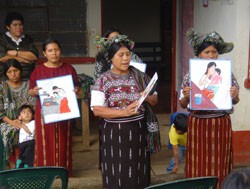
Challenge
Rural Guatemalan families that were already living in poverty and malnourished were severely affected in 2001 by natural disasters, a drop in export prices (particularly coffee), and a global economic recession. Among other consequences, these events precipitated a severe nutrition crisis, suddenly taking many lives, particularly among women and children.
Initiative
USAID worked with the Ministry of Health on a national strategy to strengthen grassroots health awareness and focus resources on vulnerable groups. Using colorful materials developed by USAID and tested for low-literate audiences, health ministry physicians and nurses trained community health volunteers and midwives to help families monitor their children’s growth, promote health and nutrition of children under five, detect high-risk pregnancies, counsel on birth spacing, and prevent disease. Volunteers visit community health centers daily to diagnose, treat, and refer patients to doctors. The program worked with 1,000 community health centers and prepared 14,000 volunteers to monitor growth and prevent childhood illnesses and malnutrition. Volunteers deliver services to hard-to-reach rural indigenous families most susceptible to crises like those that hit rural Guatemala in 2001.
Results
By delivering services directly to poor rural families in their own communities, the strategy has helped reduce malnutrition, illness, and death. Data from 6,600 volunteers show that among 13,000 children monitored over four months, malnutrition rates decreased significantly. Mothers now learn about reproductive health and child nutrition and immunization in their own communities. Before, it took three separate visits to far-away health posts to get this information. USAID is supporting the health ministry’s efforts to refine and expand this strategy nationwide. This means that more than 20,000 health volunteers will be helping mothers in remote areas take better care of themselves and their children.







Comment
Make a general inquiry or suggest an improvement.